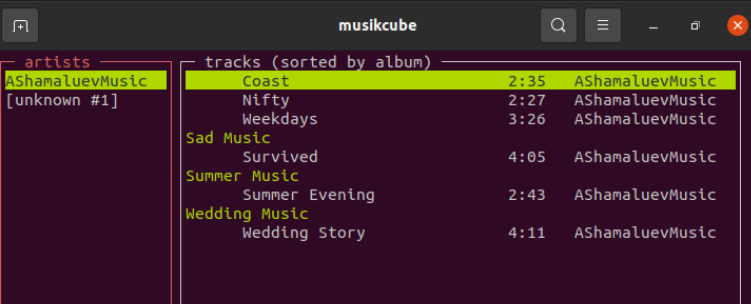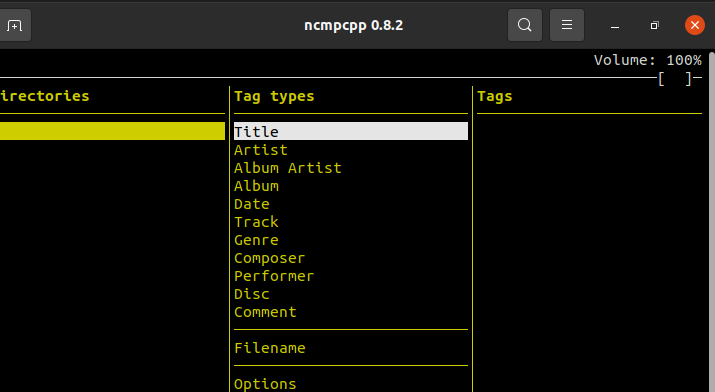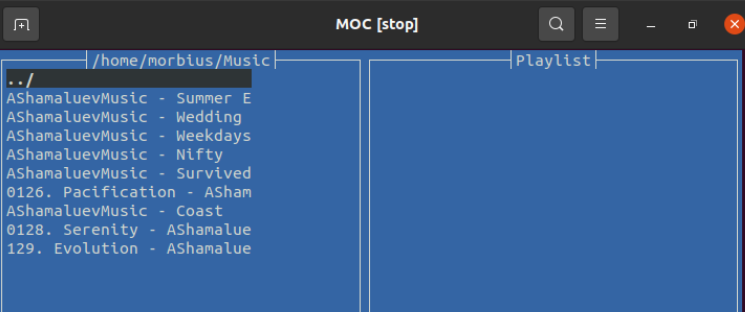Linux terminal is used for performing administrative tasks without having any issues. However, many people don't know that we can play music through the command line. Linux provides different CLI music players by which users can play the audio files from the terminal.
CLI music players are simple to use and consume lesser memory. This article briefs about the 6 best command line Music players for Linux in 2023.
1. CMUS
CMUS (Console Music Player) is a fast and compact console audio player developed in C programming for Linux operating systems. It is one of the best CLI music players because it supports various audio formats and easy-to-use commands. CMUS operates through the specific text-based UI. It is distributed under the GPL-2.0 terms. Considering the audio format support, CMUS can play music of various formats like acc, mp3, FLAC, wave, and many more. Users require to type cmus in the terminal to open play the music.
Features of CMUS
- CMUS has ReplayGain support
- There is a huge list of keyboard shortcuts to make things easier.
- It supports Ogg and MP3 streaming.
- It has compilation handling and queue options.
- Users can control it by the cmus-remote program.

How to Install CMUS
So here are the commands for installing CMUS in different Linux OS:
On Ubuntu, Debian:
sudo apt install cmus On AlmaLinux, Fedora, RHEL:
sudo dnf install cmusOn Manjaro, Arch Linux:
sudo pacman -S cmus2. Musikcube
Musikcube is an absolutely free CLI-based music player that provides cross-platform support to play music from the terminal. It provides multiple options such as tag indexing, playlist crud, file scanning, crossfading playback, great plugin architecture, and support for the music libraries. Musikcube uses different plugins which are written in C++. This plugin provides the function for digital signal processing, data streaming, metadata parsing, audio decoding, and so on. Musikcube currently supports a wide range of audio codecs like FLAC, MP3, Ogg, M4A, and many more.
Feature of Musikcube
- Musikcube has cross-platform support
- It supports different audio formats, including MP3, Ogg, M4A, etc.
- It uses the SQLite database library to save the playlist metadata and track.
- Users can download and use different plugins to make their experience smoother.
- Users can stream audio through the integrated server.

How to Install Musikcube
Musikcube is available in the snap store. You can easily install it in Linux using:
sudo snap install musikcube3. Ncmpcpp
Ncmpcpp is a command-line music player client for MPD (Music Player Daemon). It offers an amazing way to play the audio files from the Linux terminal easily.
Ncmpcpp provides different configurable options to customize the interface and everything according to the requirements. It also has key bindings and a chat protocol for communicating with other clients. By default, the system connects Ncmpcpp to a local MPD instance, but you can select various MPD instances through the command-line options.
Features of Ncmpcpp
- Ncmpc provides different options to customize the interface accordingly.
- There is a key bindings option.
- It is easy to format songs with metadata delimiters
- Users can install and use different plugins as it is an MPD client.

How to install Ncmpcpp
You can install Ncmpcpp through the following ways:
On Ubuntu, Debian:
sudo apt install mpdsudo apt install ncmpcppOn AlmaLinux, Fedora, RHEL
sudo dnf install mpdsudo dnf install ncmpcpp
On Manjaro, Arch Linux
sudo pacman -S mpd --noconfirm
sudo pacman -S ncmpcpp --noconfirm4. MOC
MOC (Music on Console) is the ncurses-based Command-Line music player. With this package, you can easily play music from the Linux terminal with a streamlined interface. MOC offers various customizable options like color schemes, key bindings, and interfaces.
It supports various audio formats like MP3, WAV, MOD, FLAC, MIDI, Musepack, Ogg, etc. According to the latest updates, MOC is supporting new audio formats, including SHOUTcast and Icecast. MOC uses a thread with an output buffer to avoid skipping under high load conditions.
Feature of MOC
- MOC supports the customizable creation of titles from tags and filenames.
- It supports different color themes and customizable options.
- It has a simple equalizer and mixer for better sound quality.
- It supports various audio formats, including MP3, AAC, OGG, FLAC, and many more.
- MOC supports JACK, SNDIO, OSS, and ALSA output.

How to Install MOC
So here are the commands to install MOC in different Linux OS:
On Ubuntu, Debian:
sudo apt install mocOn AlmaLinux, Fedora, RHEL:
sudo dnf install mocOn Manjaro, Arch Linux:
sudo pacman -S moc5. Tizonia
Tizonia is an amazing cloud-based music player with support for SoundCloud, Spotify, TuneIn, Google Play Music, YouTube, Plex servers, and many more. It is an open-source command-line music player for Linux and Mac OS.
According to the official website of Tizonia, it is the world's first music player to have OpenMAX IL1.2. It has a REPL command-line interface support.
Features of Tizonia
- Tizonia has different audio format support like MP3, FLAC, WAV, MP3, OGG, OPUS, OGG, and many more.
- Its multimedia framework is based upon the OpenMAX IL 1.2. That's why it doesn't require FFmpeg, GStreamer, libav.
- It has SHOUTcast or Icecast LAN for all local audio files.
- It has multi-platform support.
How to Install Tizonia
On Ubuntu, Debian:
curl -kL https://github.com/tizonia/tizonia-openmax-il/raw/master/tools/install.sh | bashOn AlmaLinux, Fedora, RHEL:
sudo snap install tizoniaOn Manjaro, Arch Linux:
git clone https://aur.archlinux.org/tizonia-all.git
cd tizonia-all
makepkg -si6. Tera
Tera (Terminal Radio) is an easy-to-use command-line music player for Linux. Users can play their favorite music, radio stations and explore various radio stations from the terminal only. Tera also offers an option to CRUD the favorite music list as it saves these lists into the ~/.config/tera/favorite and uses the ~/.cache/tera directory for keeping the search results. Users can also save the radio station to any list after playing.
Features of Tera
- Tera supports more than 27780 radio stations which are powered by the radio browser API.
- Users can CRUD (create, read, update, delete) favorite lists.
- Users can search a specific radio station by name, tag, country, language, code, etc.
- Users can save and delete a radio station from the created list.

How to Install Tera
On Ubuntu, Debian:
Use the following command after downloading Tera from the official Github page
sudo apt install ./tera_0.4.1_all.debConclusion
Linux command-line music players provide a compact platform to play audio files without consuming higher memory or space. You can control these music players through different commands.




Comments